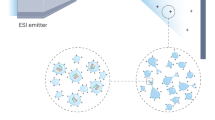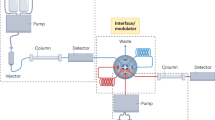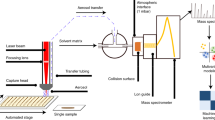Abstract
In this protocol, the sample (which could be a bulk or heterogeneous fluid, or a greasy surface) is treated with a neutral desorption (ND) sampling gas beam, and the resulting analyte mixtures are directly characterized by extractive electrospray ionization mass spectrometry (EESI-MS). The ND device can be specifically constructed such that the sampling gas beam is bubbled through the liquid sample (microjet sampling) or directed to impact the sample surface (e.g., for the analysis of a material like cheese). The ND-EESI-MS analysis process requires no sample pretreatment because it can tolerate an extremely complex matrix. ND-EESI-MS allows real-time, online chemical profiling of highly viscous samples under ambient conditions. Both volatile and nonvolatile analytes from viscous samples can easily be detected and quantified by ND-EESI-MS, thereby providing an MS-based analytical platform for multiple disciplines (e.g., for the food industry, for drug discovery, and for the biological and life sciences). Here we describe the ND-EESI-MS protocol for viscous sample analysis, including the experimental design, equipment setup, reagent preparation, data acquisition and analysis steps. The data collection process takes <1 min per sample, although the time required for the whole procedure, which largely depends on the experimental preparation processes, might be considerably longer.
This is a preview of subscription content, access via your institution
Access options
Subscribe to this journal
Receive 12 print issues and online access
$259.00 per year
only $21.58 per issue
Buy this article
- Purchase on Springer Link
- Instant access to full article PDF
Prices may be subject to local taxes which are calculated during checkout















Similar content being viewed by others
References
Cooks, R.G., Ouyang, Z., Takats, Z. & Wiseman, J.M. Ambient mass spectrometry. Science 311, 1566–1570 (2006).
Reed, R.I. Ion Production by Electron Impact (Academic Press, 1962).
Munson, M.S.B. & Field, F.H. Chemical ionization mass spectrometry. I. General introduction. J. Am. Chem. Soc. 88, 2621–2630 (1966).
Yamashita, M. & Fenn, J.B. Electrospray ion source: another variation on the free-jet theme. J. Phys. Chem. 88, 4451–4459 (1984).
Fenn, J.B., Mann, M., Meng, C.K., Wong, S.F. & Whitehouse, C.M. Electrospray ionization for mass spectrometry of large biomolecules. Science 246, 64–71 (1989).
Garcia, D.M., Huang, S.K. & Stansbury, W.F. Optimization of the atmospheric pressure chemical ionization liquid chromatography mass spectrometry interface. J. Am. Soc. Mass Spectrom. 7, 59–65 (1996).
Smith, C.J. et al. Determination of selected monohydroxy metabolites of 2-, 3- and 4-ring polycyclic aromatic hydrocarbons in urine by solid-phase microextraction and isotope dilution gas chromatography-mass spectrometry. J. Chromatogr. B 778, 157–164 (2002).
de la Cal, A ., Eljarrat, E. & Barceló, D. Determination of 39 polybrominated diphenyl ether congeners in sediment samples using fast selective pressurized liquid extraction and purification. J. Chromatogr. A 1021, 165–173 (2003).
Galceran, M.T. & Moyano, E. Determination of hydroxy polycyclic aromatic hydrocarbons by liquid chromatography-mass spectrometry comparison of atmospheric pressure chemical ionization and electrospray. J. Chromatogr. A. 731, 75–84 (1996).
Van-de-Wiele, T.R., Peru, K.M., Verstraete, W., Siciliano, S.D. & Headley, J.V. Liquid chromatography-mass spectrometry analysis of hydroxylated polycyclic aromatic hydrocarbons, formed in a simulator of the human gastrointestinal tract. J. Chromatogr. B. 806, 245–253 (2004).
Xu, X., Zhang, J.F., Zhang, L., Liu, W.L. & Weisel, C.P. Selective detection of monohydroxy metabolites of polycyclic aromatic hydrocarbons in urine using liquid chromatography/triple quadrupole tandem mass spectrometry. Rapid Commun. Mass Spectrom. 18, 2299–2308 (2004).
Takats, Z., Wiseman, J.M., Gologan, B. & Cooks, R.G. Mass spectrometry sampling under ambient conditions with desorption electrospray ionization. Science 306, 471–473 (2004).
Ifa, D.R., Manicke, N.E., Rusine, A.L. & Cooks, R.G. Quantitative analysis of small molecules by desorption electrospray ionization mass spectrometry from polytetrafluoroethylene surfaces. Rapid Commun. Mass Spectrom. 22, 503–510 (2008).
Shin, Y.S., Drolet, B., Mayer, R., Dolence, K. & Basile, F. Desorption electrospray ionization-mass spectrometry of proteins. Anal. Chem. 79, 3514–3518 (2007).
Cody, R.B., Laramée, J.A. & Durst, H.D. Versatile new ion source for the analysis of materials in open air under ambient conditions. Anal. Chem. 77, 2297–2302 (2005).
Haefliger, O.P. & Jeckelmann, N. Direct mass spectrometric analysis of flavors and fragrances in real applications using DART. Rapid Commun. Mass Spectrom. 21, 1361–1366 (2007).
Nemes, P. & Vertes, A. Laser ablation electrospray ionization for atmospheric pressure, in vivo, and imaging mass spectrometry. Anal. Chem. 79, 8098–8106 (2007).
Nemes, P., Barton, A.A. & Vertes, A. Three-dimensional imaging of metabolites in tissues under ambient conditions by laser ablation electrospray ionization mass spectrometry. Anal. Chem. 81, 6668–6675 (2009).
Shrestha, B. & Vertes, A. In situ metabolic profiling of single cells by laser ablation electrospray ionization mass spectrometry. Anal. Chem. 81, 8265–8271 (2009).
Na, N., Zhao, M.X., Zhang, S.C., Yang, C.D. & Zhang, X.R. Development of a dielectric barrier discharge ion source for ambient mass spectrometry. J. Am. Soc. Mass Spectrom. 18, 1859–1862 (2007).
Chen, H.W. et al. Surface desorption atmospheric pressure chemical ionization mass spectrometry for direct ambient sample analysis without toxic chemical contamination. J. Mass Spectrom. 42, 1045–1056 (2007).
Yang, S.P. et al. Detection of melamine in milk products by surface desorption atmospheric pressure chemical ionization mass spectrometry. Anal. Chem. 81, 2426–2436 (2009).
McEwen, C.N., McKay, R.G. & Larsen, B.S. Analysis of solids, liquids, and biological tissues using solids probe introduction at atmospheric pressure on commercial LC/MS instruments. Anal. Chem. 77, 7826–7831 (2005).
Harper, J.D. et al. Low-temperature plasma probe for ambient desorption ionization. Anal. Chem. 80, 9097–9104 (2008).
Huang, G.M., Ouyang, Z. & Cooks, R.G. High-throughput trace melamine analysis in complex mixtures. Chem. Commun. 2009, 556–558 (2009).
Huang, M.Z. et al. Characterization of the chemical components on the surface of different solids with electrospray-assisted laser desorption ionization mass spectrometry. Rapid Commun. Mass Spectrom. 21, 1767–1775 (2007).
Lin, S.Y., Huang, M.Z., Chang, H.C. & Shiea, J. Using electrospray-assisted laser desorption/ionization mass spectrometry to characterize organic compounds separated on thin-layer chromatography plates. Anal. Chem. 79, 8789–8795 (2007).
Shiea, J. et al. Electrospray-assisted laser desorption/ionization mass spectrometry for direct ambient analysis of solids. Rapid Commun. Mass Spectrom. 19, 3701–3704 (2005).
Andrade, F.J. et al. Atmospheric pressure chemical ionization source. 1. Ionization of compounds in the gas phase. Anal. Chem. 80, 2646–2653 (2008).
Haapala, M. et al. Desorption atmospheric pressure photoionization. Anal. Chem. 79, 7867–7872 (2007).
Huang, G.M., Chen, H., Zhang, X.R., Cooks, R.G. & Ouyang, Z. Rapid screening of anabolic steroids in urine by reactive desorption electrospray ionization. Anal. Chem. 79, 8327–8332 (2007).
Chen, H.W., Hu, B. & Zhang, X. Principle and application of ambient mass spectrometry for direct analysis of complex samples. Chinese J. Anal. Chem. 38, 1069–1088 (2010).
Fuerstenau, S., Kiselev, P. & Fenn, J.B. in Proceedings of the 47th ASMS Conference on Mass Spectrometry and Allied Topics (Dallas, Texas, USA 1999).
Wu, C., Siems, W.F. & Hill, H.H.J. Secondary electrospray ionization ion mobility spectrometry/mass spectrometry of illicit drugs. Anal. Chem. 72, 396–403 (2000).
Shieh, I.F., Lee, C.Y. & Shiea, J. Eliminating the interferences from TRIS buffer and SDS in protein analysis by fused-droplet electrospray ionization mass spectrometry. J. Proteome Res. 4, 606–612 (2005).
Chen, H.W., Venter, A. & Cooks, R.G. Extractive electrospray ionization for direct analysis of undiluted urine, milk and other complex mixtures without sample preparation. Chem. Commun. 2006, 2042–2044 (2006).
Law, W.S. et al. On the mechanism of extractive electrospray ionization. Anal. Chem. 82, 4494–4500 (2010).
Venter, A., Sojka, P.E. & Cooks, R.G. Droplet dynamics and ionization mechanisms in desorption electrospray ionization mass spectrometry. Anal. Chem. 78, 8549–8555 (2006).
Zhou, Z.Q. et al. Rapid detection of atrazine and its metabolite in raw urine by extractive electrospray ionization mass spectrometry. Metabolomics 3, 101–104 (2007).
Chingin, K., Gamez, G., Chen, H.W., Zhu, L. & Zenobi, R. Rapid classification of perfumes by extractive electrospray ionization mass spectrometry (EESI-MS). Rapid Commun. Mass Spectrom. 22, 2009–2014 (2008).
Chen, H.W., Wortmann, A., Zhang, W.H. & Zenobi, R. Rapid in vivo fingerprinting of nonvolatile compounds in breath by extractive electrospray ionization quadrupole time-of-flight mass spectrometry. Angew. Chem. Int. Ed. 46, 580–583 (2007).
Ding, J. et al. Development of extractive electrospray ionization ion trap mass spectrometry for in vivo breath analysis. Analyst 134, 2040–2050 (2009).
Chingin, K., Chen, H.W., Gamez, G., Zhu, L. & Zenobi, R. Detection of diethyl phthalate in perfumes by extractive electrospray ionization mass spectrometry. Anal. Chem. 81, 123–129 (2009).
Zhu, L. et al. Real-time, on-line monitoring of organic chemical reactions using extractive electrospray ionization tandem mass spectrometry. Rapid Commun. Mass Spectrom. 22, 2993–2998 (2008).
Law, W.S. et al. Rapid characterization of complex viscous liquids at the molecular level. Angew. Chem. Int. Ed. 48, 8277–8280 (2009).
Ding, J.H. et al. Selective detection of diethylene glycol in toothpaste products using neutral desorption reactive extractive electrospray ionization tandem mass spectrometry. Anal. Chem. 81, 8632–8638 (2009).
Zhu, L. et al. Simultaneous sampling of volatile and nonvolatile analytes in beer for fast fingerprinting by extractive electrospray ionization mass spectrometry. Anal. Bioanal. Chem. 398, 405–413 (2010).
Law, W.S. et al. Rapid fingerprinting and classification of extra virgin olive oil by microjet sampling and extractive electrospray ionization mass spectrometry. Analyst 135, 773–778 (2010).
Wu, Z.C. et al. Sampling analytes from cheese products for fast detection using neutral desorption extractive electrospray ionization mass spectrometry. Anal. Bioanal. Chem. 397, 1549–1556 (2010).
Weston, D.J. Ambient ionization mass spectrometry: current understanding of mechanistic theory; analytical performance and application areas. Analyst 135, 661–668 (2010).
Chen, H.W., Wortmann, A. & Zenobi, R. Neutral desorption sampling coupled to extractive electrospray ionization mass spectrometry for rapid differentiation of biosamples by metabolomic fingerprinting. J. Mass Spectrom. 42, 1123–1135 (2007).
Chen, H.W., Yang, S.P., Wortmann, A. & Zenobi, R. Neutral desorption sampling of living objects for rapid analysis by extractive electrospray ionization mass spectrometry. Angew. Chem. Int. Ed 46, 7591–7594 (2007).
Chen, H.W. & Zenobi, R. Neutral desorption sampling of biological surfaces for rapid chemical characterization by extractive electrospray ionization mass spectrometry. Nat. Protoc. 3, 1467–1475 (2008).
Chen, H.W. et al. Neutral desorption using a sealed enclosure to sample explosives on human skin for rapid detection by EESI-MS. J. Am. Soc. Mass Spectrom. 20, 719–722 (2009).
Chen, H.W. et al. Manipulation of charge states of biopolymer ions by atmospheric pressure ion/molecule reactions implemented in an extractive electrosprau ionization source. Eur. J. Mass Spectrom. 13, 273–279 (2007).
Chen, H.W. et al. Sensitive detection of native proteins using extractive electrospray ionization mass spectrometry. Angew. Chem. Int. Ed. 49, 3053–3056 (2010).
Gu, H.W. et al. Geometry-independent neutral desorption device for the sensitive EESI-MS detection of explosives on various surfaces. Analyst 135, 779–788 (2010).
Chen, H.W., Sun, Y.P., Wortmann, A., Gu, H.W. & Zenobi, R. Differentiation of maturity and quality of fruit using noninvasive extractive electrospray ionization quadrupole time-of-flight mass spectrometry. Anal. Chem. 79, 1447–1455 (2007).
Zhao, H.B., Holladay, J.E., Brown, H. & Zhang, Z.C. Metal chlorides in ionic liquid solvents convert sugars to 5-hydroxymethylfurfural. Science 316, 1597–1600 (2007).
Acknowledgements
We acknowledge the valuable help from R. Zenobi, W. Law, S. Yang, L. Zhu and Z. Hu in performing some of the EESI experiments shown here. We also acknowledge financial support from the Innovation Method Fund (no. 2008IM040400) and grants from MOST of China (nos. 2009DFA30800 and 2009DFA41880).
Author information
Authors and Affiliations
Contributions
X.L. prepared the manuscript, discussed its implications and commented on the manuscript at all stages; B.H. was involved in most of the experiments; J.D. performed the experiment of selective detection of diethylene glycol in toothpaste products; H.C. conceived the concept, designed all the experiments, outlined the protocol and revised the manuscript.
Corresponding author
Ethics declarations
Competing interests
The authors declare no competing financial interests.
Rights and permissions
About this article
Cite this article
Li, X., Hu, B., Ding, J. et al. Rapid characterization of complex viscous samples at molecular levels by neutral desorption extractive electrospray ionization mass spectrometry. Nat Protoc 6, 1010–1025 (2011). https://doi.org/10.1038/nprot.2011.337
Published:
Issue Date:
DOI: https://doi.org/10.1038/nprot.2011.337
This article is cited by
-
Mass spectrometry using electrospray ionization
Nature Reviews Methods Primers (2023)
-
Direct Analysis and Quantification of Metaldehyde in Water using Reactive Paper Spray Mass Spectrometry
Scientific Reports (2016)
-
Direct detection of chloramphenicol in honey by neutral desorption-extractive electrospray ionization mass spectrometry
Analytical and Bioanalytical Chemistry (2014)
-
Direct Characterization of Bulk Samples by Internal Extractive Electrospray Ionization Mass Spectrometry
Scientific Reports (2013)
-
Facilitated Diffusion of Acetonitrile Revealed by Quantitative Breath Analysis Using Extractive Electrospray Ionization Mass Spectrometry
Scientific Reports (2013)
Comments
By submitting a comment you agree to abide by our Terms and Community Guidelines. If you find something abusive or that does not comply with our terms or guidelines please flag it as inappropriate.



